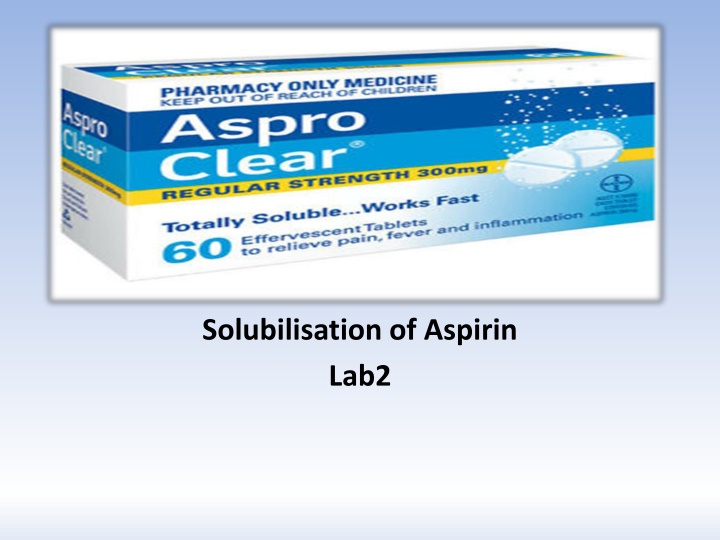
Enhancing Aspirin Solubility Through Interactions and Forces
Explore the methods of enhancing aspirin solubility through surface active agents, salt formation, and dipole-dipole interactions. Learn about intramolecular and intermolecular forces that play a crucial role in determining the physical properties of molecules like melting point and boiling point. Discover how companies are creating soluble aspirin formulations for faster pain relief.
Download Presentation

Please find below an Image/Link to download the presentation.
The content on the website is provided AS IS for your information and personal use only. It may not be sold, licensed, or shared on other websites without obtaining consent from the author. If you encounter any issues during the download, it is possible that the publisher has removed the file from their server.
You are allowed to download the files provided on this website for personal or commercial use, subject to the condition that they are used lawfully. All files are the property of their respective owners.
The content on the website is provided AS IS for your information and personal use only. It may not be sold, licensed, or shared on other websites without obtaining consent from the author.
E N D
Presentation Transcript
LAB 2 Solubilisation of Aspirin Lab2
Introduction Acetylsalicylic acid is the scientific name of the aspirin, yet currently explored by various companies for commercial benefits. Soluble formulations of aspirin are currently available on the market. Basically, it is slightly soluble in water; hence, aspirin needs enhancements to be solubilized as:
Enhancement of aspirin solubilization SURFACE ACTIVE AGENT Adding sodium citrate or tri- Na citrate Solubilisation of Aspirin SALT FORMATION through Dipole dipole interaction Complex formation
For instance, Aspro Clear is soluble, effervescent tablet containing aspirin. The effervescence and favourable pH condition required for solubility of aspirin are facilitated by: incorporating sodium bicarbonate and citric acid in the formulation. Aspro Clear reported to provide faster relief of pain than plain aspirin tablets. Another method is by forming interaction. dipole-dipole
II. Kinds of forces Generally, there are two kinds of forces, or attractions, which operate in a molecule: intramolecular and intermolecular. Intramolecular forces are the forces that hold atoms together within a molecule. Intermolecularforces are forces that exist between molecules (Figure: 1).
Intermolecular forces are much weaker than the intramolecular forces of attraction but are important because they determine the physical properties of molecules like
Physical properties melting point Boiling point Enthalpies of fusion And vaporization
Therefore, the intermolecular force: 1. Hydrogen bond. 2. the category of van der Waal forces London dispersion forces, under 3. Dipole-dipole Interactions:
Dipole Dipole interaction These forces occur when the partially positively charged part of a molecule interacts with the partially negatively charged part of the neighboring molecule (Figure 2). Dipole-dipole interactions are the strongest intermolecular force of attraction.
III. Experimental Work Part l: MATERIALS :Acetyl salicylic acid , tri-sodium citrate, distilled water, phenol red , sodium hydroxide and filter paper GLASS WARE and EQUIPMENTS : conical flasks, graduated pipettes, funnel, burette. In addition to electrical balance.
Part ll: Experimental method 1. Add 1 g of Aspirin to the following flasks then : Weight of tri- sodium citrate Conical flask 1 0 g 2 1 g 3 2 g 4 3 g 5 4 g
2. Add 50 mL of distilled water to each flask. 3. Shake the flasks for 10 min., then apply filtration step. (Rinse the flask with the first portion of the filtrate). 4. Take 10 mL of the filtrate solution and titrate with NaOH (0.1N) using phenol red as an indicator. 5. Record the end point taking into account the end point appears when the colour changes from yellow to pink. 6. Finally, plot percent of aspirin dissolved versus grams tri-sodium citrate used
When the amount of tri-sodium citrate is higher than that required for dissolving aspirin, the excess will dissociate to citrate ion and sodium ion, the later will form with water NaOH which results in the reaching the end point faster, and less than the real end point.
The chemical factor will be: 1 M.wt Aspirin = 1 M.wt NaOH 1eq.wt of aspirin = 1eq.wt of NaOH 180 g = 1L of 1N NaOH 180/1000 g = 1ml of 1N NaOH 180/1000* 0.1 = 1ml of 0.1N NaOH Each 1ml of 0.1N NaOH = 0.018 g Aspirin End point * chemical factor = g aspirin dissolve in 10ml Multiply the results by 10 = g%.
IV. Reports Write a report with highlighting on the results and discussion part.
References 1. Martins Physical Pharmacy and pharmaceutical science- 6th.ed-2011 2. http://ac.els-cdn.com/S2211383515001069/1-s2.0- S2211383515001069-main.pdf?_tid=9597cd7c-fb8b- 11e6-b84c- 00000aab0f26&acdnat=1488048941_958bd678c9ec741 d93ea752d7cb6ce5f 3. https://link.springer.com/article/10.1007/s11165-007- 9050-0






















